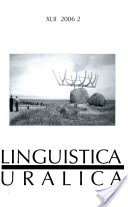Drei (mittel)europäische Isoglossen
Three European Isoglosses
Author(s): László HontiSubject(s): Language and Literature Studies
Published by: Eesti Teaduste Akadeemia Kirjastus
Keywords: Hungarian; language contact; numerals; morphosyntax; case suffix; Sprachbund
Summary/Abstract: The paper deals with parallels between the Hungarian, Slavic and Balkan expressions for the numbers 11--19 and between the German and Slavic structures denoting 'one' in the higher tens, as well as temporal use of the instrumental (comitative) in Hungarian and Slavic. I conclude that those constructions are independent of each other. True, some of them have become generalized, but in this process the neighbour languages can be suspected to have had, at most, a conveyor role. I am actually rather sceptical about the possibility of direct borrowing of morphosyntactic constructions. According to my experience, such borrowing may happen only if (a) the object of borrowing in a way already exists in the receiver language, potentially at least, thus not being typologically unacceptable, and (b) if the speakers of the two languages have a cultural relationship, like living in the same community or in close symbiosis.
Journal: Linguistica Uralica
- Issue Year: XLII/2006
- Issue No: 2
- Page Range: 112-126
- Page Count: 15
- Language: German

